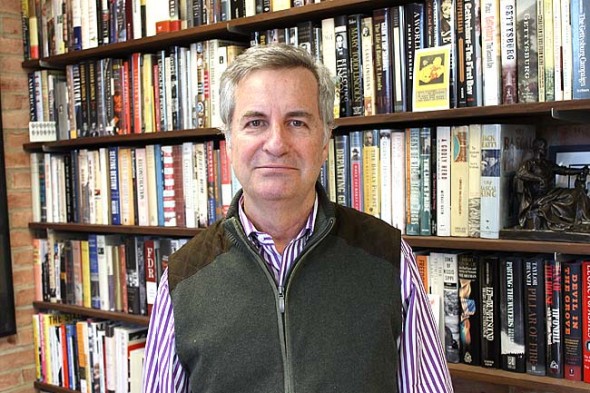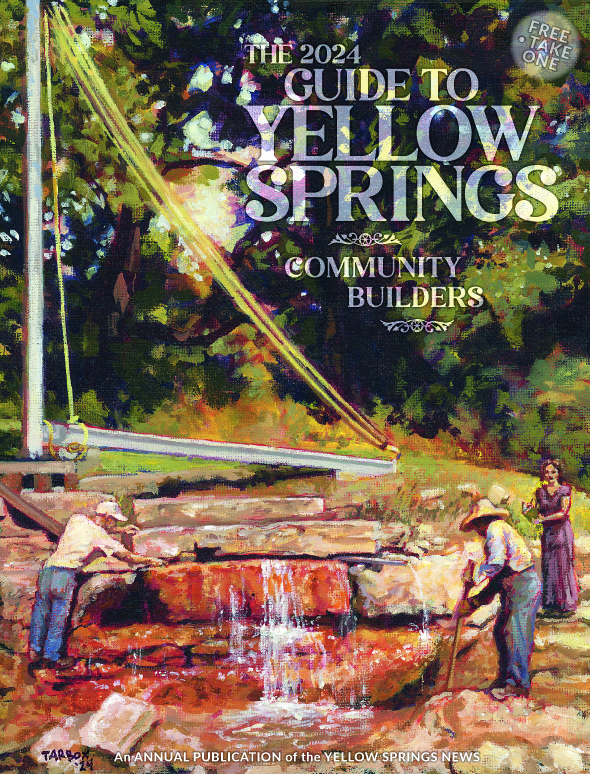
Mark Roosevelt, the first president of the revived Antioch College, is leaving the job after five years to become president of St. John’s College in Santa Fe, N.M. Roosevelt and his wife, Dorothy, will be honored Thursday, Dec. 3, from 4 to 6 p.m. at Herndon Gallery. The event is open to the community. (submitted Photo)
Roosevelt tenure: healing wounds, raising the college
- Published: December 10, 2015
When Mark Roosevelt was a newly elected Massachusetts state legislator in 1986, he was asked to be lead sponsor of a bill that would prohibit housing and employment discrimination against gays and lesbians. If passed, the state would become only the second in the nation to protect homosexuals.
Even though it guaranteed that the bill wouldn’t pass, Democratic leaders told Roosevelt not to bother talking to about 90 out of the state’s 160 legislators, because those legislators opposed the bill. But Roosevelt insisted on speaking to all, even though it took far longer to do so, and the chances for passage seemed slim.
“It was a rough two years,” Roosevelt said about the process in a recent interview. “But ultimately, many of those 90 legislators voted with us. The bill passed.”
He tells this story often, Roosevelt said, because the experience made such an impact on him.
“The lesson to me was, don’t write people off. Assume people have some decency in them,” he said.
It’s a lesson that has served Roosevelt well since he came to Antioch College in 2011 as the first president of the newly revived college. While Roosevelt, formerly Pittsburgh school superintendent, knew the job would prove challenging, he didn’t know quite how challenging it would be.
After arriving on campus, Roosevelt wasn’t surprised to find that his most pressing task was raising the money needed to revive the historic college. But he was surprised to find that the most wrenching challenge was addressing the acrimony he saw all around him.
“There was a lot of anger, a lot of woundedness,” he said.” “People were quick to go to the barricades.”
The acrimony arose from many sources. Former faculty, along with many community supporters and former students, felt betrayed that they weren’t getting their tenured positions back. College alumni were divided over the former faculty issue, with some refusing to donate if former faculty were rehired and others refusing to donate if they were not.
Some alumni were upset and angry at the state of the campus, which had been allowed to deterioriate for years. Many refused to donate (at the time, only 3 percent of alums gave to the college) after what they perceived was the decline of Antioch’s academic stature and campus climate.
“I’ve never been in a job where so many people cried in my office,” Roosevelt said.
Five years later, Roosevelt believes that much has changed. Thirty percent of alumni now donate to Antioch, and the number of disgruntled alumni has significantly declined.
“Most of those people who had written off the college are back,” he said.
Most meaningful to Roosevelt, he sees an improvement in the level of civility in campus dialogue.
Recently, for example, administrators met with students in a tense gathering regarding a student who had been expelled for reasons of academic dishonesty. While administrators were prohibited by federal law from discussing specifics of the case, they listened to the concerns of students, who supported the young man who had been expelled.
“There was no disrespect shown, students were forceful but not angry,” he said. “Not everyone was happy. Still, the discussion had a tone of mutual respect.”
Roosevelt gives credit to the college’s current administrators, faculty and students for fostering a campus climate that, while still having room for improvement, is less divisive than it has been in years. And having learned well the lesson from his legislative experience, he hopes he played a part in creating a space where difficult discourse can be respectful.
“I think people here feel respected and heard. And I hope I contributed to that,” he said.
But the battles of Roosevelt’s five years on the job — with former faculty, students, alumni and past leaders of Antioch University — took their toll. For Roosevelt, the effects of past acrimony is part of the reason he’s choosing to leave at the end of his first five-year contract.
“There are wounds I have that Tom Manley [the new president] does not have, and that it’s best not to have,” he said. “It took something out of me.”
In the end, Roosevelt believes he did the best he could for as long as he could in a difficult situation. And now it’s time to move on.
“I believe I’ve helped heal the wounds,” he said. “We’re in the game now. We’ve got a chance.”
The right time
The time is right to leave his job, Roosevelt believes, partly because many things are going well for Antioch College.
Most important is the likelihood that the college will receive accreditation in June, after a process that lasted more than six years.
While the Higher Learning Commission, or HLC, hasn’t yet informed Roosevelt of the results of its final visit earlier this month (and he isn’t allowed to say anything when he hears them), he is hopeful. The college community was well prepared for the visit, he said, and the exit interview with the HLC team was positive.
“I feel confident. I can say that,” Roosevelt said.
Achieving accreditation is huge for the college. Without it, the school’s programs and courses lack legitimacy, international students aren’t able to attend and most important, students aren’t eligible to receive federal grants or loans.
“It’s the whole shebang,” Roosevelt said in a previous interview.
Along with progress in accreditation, Roosevelt believes the college has benefitted from a revitalized relationship with the Yellow Springs community.
Since its rebirth, college leaders have collaborated with villagers on several building projects to benefit both entities, including the Wellness Center and the Foundry Theater. The Coretta Scott King Center, the Antioch Farm and the proposed Antioch College Village have also captivated villagers’ interest.
As evidence of the strengthened town/gown connection, Roosevelt cited the community input required for the most recent HLC site visit. Villagers contributed more than 60 pages of comments during the recent visit and not a single comment was negative — in contrast to those for the 2013 site visit, which did include negative responses.
The overwhelmingly positive feedback from Yellow Springs community members is a significant development for the college, according to Roosevelt.
“That was stunning,” he said.
Struggles ahead
But Roosevelt is clear that the road ahead isn’t easy, and finances remain a huge concern. Though about $75 million has been raised for campus renovations, meeting each year’s cash-flow needs remains the greatest challenge for college leaders.
Specifically, the college is capable of raising about $9 or 10 million yearly, but the college’s annual budget has remained $17 to 19 million annually.
“Raising $19 million a year is really hard,” he said.
Due to the small number of students and the fact that the college’s first students were offered free tuition, Antioch is now funded about 85 percent by donations, a percentage that is not sustainable, he said. Consequently, leaders are working on both increasing enrollment — up from about 230 now to about 650 students in 2021 — and bringing in more tuition income to drive the donation-driven percentage down to about 50 to 60 percent.
While a larger number of tuition-paying students will help address the financial challenge, more alumni and community members also need to contribute to the college.
“Those who have remained skeptics need to get more deeply involved,” Roosevelt said. “All hands are not yet on deck.”
The mission of Antioch is especially relevant in these times, Roosevelt believes. In an economy in which young people find it ever more difficult to find meaningful work, the college’s signature work/study program provides “academics illuminated by work,” allowing young people the opportunity to find their vocational path in a deeper way than that offered by most liberal arts colleges. And the college’s recent revival means it’s more nimble than most, so that Antioch can restructure its academic program to meet changing real-world needs.
What Roosevelt feels most proud of at the end of his tenure is the level of dedication, professionalism and idealism in the college’s current faculty, staff and students. People have taken risks and made sacrifices to work or study at the revived Antioch College, he said, and he finds inspiration in those sacrifices.
“Antioch College represents a dream,” he said. “It’s a place where people come together to seek new and better ways of living. This is something that people want to be a part of.”
And the dream is critical to the college’s survival, he believes. “Without it,” he said, “we’re not in the game.”
A difficult beginning
When Roosevelt was named the first president of the reborn college in 2010, he was an unconventional choice, having never led a college before. Rather, he came to Yellow Springs after turning around a floundering public school system in Pittsburgh, Pa.
According to Roosevelt, the irony of his new job was that in Pittsburgh he’d been hired mainly to close schools, while in Yellow Springs, he was charged with opening one.
And while Roosevelt’s work in Pittsburgh was emotionally difficult, there was never a question that the city’s public school system would close if he failed. But at Antioch, the possibility of the college not making it was a very real option.
There were four or five times in his first five years when Roosevelt thought the college might fail, he said recently. The first, and most difficult, was a point early in his tenure when the college, already in trouble financially because the original estimate for needed campus renovations had been upped from $30 million to $100 million, was informed by the HLC that the preliminary form, or PIF, that had been submitted (by previous college leaders) to start the process of gaining accreditation had been rejected.
“We were being told that we weren’t even ready to start the process,” he said. “That was a very gut-check moment.”
Another near-turning point came two years later when the college, in order to fund the higher-than-expected campus renovation, sought legal approval to borrow against its endowment. However, Antioch University leaders appeared in court to oppose the action because the college had agreed to a reversion clause when it gained independence, granting the university the right to the campus should the college fail within a specific timeline. The judge told the two parties to work things out between them, and after tough negotiations, the college purchased WYSO from the university for $8 million, and also nullified the reversion clause.
Several other difficult points in his five years “were all tied to finances,” Roosevelt said. And at each juncture, the small group of “relatively wealthy people” who had lent significant support previously were asked to dig deeper to help the college.
“Magnificently, they were able to do so,” Roosevelt said.
Still, the need for constant fundraising links to his biggest regret, he said, citing his frequent travel. He had wanted to teach, to engage more with the college community. “I don’t think I was enough of a presence on campus,” he said.
However, while finances remained the most pressing concern, in his first year on the job Roosevelt’s most wrenching challenge was the former faculty issue.
The former faculty of the closed Antioch, which numbered about 30, believed that the college was obligated to hire them back, and the American Association of University Professors, or AAUP, backed their claim.
But the reborn Antioch College didn’t hire back former faculty for a variety of reasons, Roosevelt said. First, the college’s first group of hires numbered six tenure-track faculty; the college didn’t have the resources to hire 30.
And many of the alumni leaders blamed former faculty for the school’s demise, refusing to donate to the revived Antioch if they were rehired.
Roosevelt was taken aback by the level of rancor from both former faculty and alumni around the issue, he said.
“I didn’t expect it to be so hard,” he said. “I expected that genial, straightforward people could work through these issues. But about 30 percent of my time went to healing those wounds.”
In the end, the faculty hiring committee rather than Roosevelt made hiring decisions, and one former faculty member, chemist David Kammler, was hired back as one of the initial six.
However, Roosevelt then brought several former faculty back in administrative positions, with Hassan Rahmanian overseeing academic affairs, Louise Smith in charge of community life and Dennie Eagleson curating exhibits in the Herndon Gallery.
Now, after five years have passed, about 80 percent of alumni and community members believe that college leaders did as well as could be expected handling the difficult situation, Roosevelt said.
“I believe we did the best that we could,” he said, adding, “It doesn’t mean some weren’t injured. Sometimes there is right on both sides.”
Overall, Roosevelt’s tenure at Antioch College has been impressive on many levels, according to Antioch College Board of Trustees President Fran Horowitz in a written statement.
“During the five years of Mark Roosevelt’s leadership, much of the beauty and infrastructure of our historic campus has been responsibly restored; a fine faculty of dedicated teachers and scholars has been recruited; courageous, adventurous and serious students have chosen to enroll; staff across all the various offices and levels of responsibility have been dedicated to seeing the College function as well as possible; a strong leadership team of committed individuals has trained its sights on strengthening the paths that will keep us true to the vision and mission of the College; and many of our Alumni have been enabled to believe again in their College and are willing to help support it. This is a truly amazing record.”
Those who wish to honor Roosevelt by contributing to the college are encouraged to donate to the Roosevelt Opportunity Fund, which will support low-income and first-generation students at Antioch. To do so, go online to antiochcollege.org/donate.
The Yellow Springs News encourages respectful discussion of this article.
You must login to post a comment.
Don't have a login? Register for a free YSNews.com account.















No comments yet for this article.